![]()
Wed, Nov 03, 2010 | The Meir Amit Intelligence and Terrorism Information Center
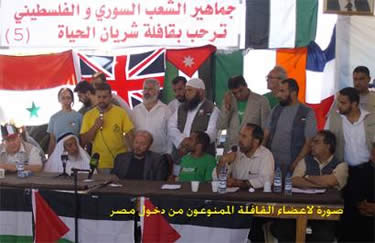
A group photo of Viva Palestina activists denied entry by the Egyptian authorities. The photograph was taken in Latakia (Al-Sabil, the Muslim Brotherhood organ in Jordan, October 17, 2010)
Egyptian Authorities Refused To Allow 17 Activists To Enter The Gaza Strip
Egyptian authorities refused to allow 17 activists from the Viva Palestina convoy to enter the Gaza Strip. Those denied entry included Viva Palestina leader George Galloway, several activists who had been aboard the Mavi Marmara, Muslim Brotherhood activists, and participants in the confrontation with Egypt’s security forces in January 2010.
Overview
After a number of delays, a ship finally set sail from the Syrian port of Latakia to the Gaza Strip on the night of October 18-19, part of an aid convoy organized by Viva Palestina. The ship, with 30 passengers on board, reached the Egyptian port of Al-Arish on October 21. About 310 more convoy participants who were unable to arrive by sea arrived at the Al-Arish airport on three airplanes under an agreement reached with the Egyptian authorities. The convoy entered the Gaza Strip on October 21 and stayed there for three days.
During negotiations between the convoy leaders and Egyptian authorities that took place while the convoy was waiting in Syria, the Egyptians announced that they would let the convoy enter the Gaza Strip only under the condition that 17 convoy participants, including Viva Palestina leader George Galloway, would not enter Egyptian territory.
The people denied entry included six Britons, nine Jordanians, and two Turkish nationals. Partial information on the activists who were denied entry shows that some of them were involved in the violent confrontation that took place between the Viva Palestina convoy and Egypt’s security forces in January 2010, while others are activists from Jordan (and possibly Turkey) affiliated with the Muslim Brotherhood and radical Islam (see Appendix I for details). According to convoy spokesman Zaher Birawi, a Hamas activist from Britain,[1] the Egyptian authorities provided no explanation for their refusal to allow those activists to enter the Gaza Strip.

Egyptian security forces clash with Lifeline 3 activists in Al-Arish over the refusal of Egyptian authorities to let some of the trucks into the Gaza Strip through the Rafah crossing (ihh.org.tr, January 2010)
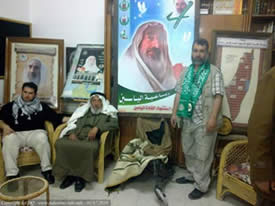
Hajj Ismail Nashwan, an Islamic activist from Jordan (most likely belonging to the Muslim Brotherhood) who along with his son was denied entry by the Egyptian authorities. See note 2
Viva Palestina and its ally organizations (mainly the Turkish IHH) have a history of violent and provocative conduct towards the Egyptian authorities during the Lifeline 3 convoy (December 2009 – January 2010). The convoy activists were involved in a violent clash with Egyptian security forces, which prompted Egypt to announce that it would not allow other such convoys to enter its territory and declare George Galloway persona non grata.[3]
An analysis of the convoy’s conduct indicates that the original Viva Palestina activists were joined by numerous activists from Jordan, the Persian Gulf, and North Africa. Some of them (mainly those from Jordan) are radical Islamic activists mostly belonging to the Muslim Brotherhood, who joined the radical left-wingers that directed the Viva Palestina convoy. Such cooperation, based on a mutual hostility towards Israel and support for Hamas, was also identified in the analysis of the Mavi Marmara activists and operatives, and among some of the organizations and activists that make up the international coalition that wages a campaign to delegitimize Israel.
Appendix I
Information on some of the Viva Palestina activists denied entry by the Egyptian authorities
The Viva Palestina convoy spent over two weeks in the Syrian port of Latakia waiting for the Egyptian authorities’ permission to come to Al-Arish. The Egyptian authorities finally agreed to let the convoy enter the Gaza Strip only if 17 convoy members, including George Galloway, did not enter Egyptian territory. Zaher Birawi, a Hamas activist in Britain who is also the spokesman for the convoy (and one of the people denied entry), condemned Egypt for its refusal to allow the activists passage to the Gaza Strip, saying that the Egyptian authorities provided no explanation for it.
A partial analysis of the names and details of the activists who were denied entry shows that some of them had been involved in the violent clash of the Viva Palestina convoy with the Egyptian security forces (January 2010). Others were activists affiliated with the Muslim Brotherhood and radical Islam who joined Viva Palestina, led by radical left-wingers. The activists who were denied entry by the Egyptian authorities include six British nationals, nine Jordanian nationals, and two Turkish nationals. At least some of them took part in the convoy that clashed with the Egyptian forces in January 2010, and some of them were aboard the Mavi Marmara in the violent flotilla of May 2010. Notable among them are Jordanian Islamists, at least one of whom was detained by the Jordanian authorities for delivering financial aid to the Gaza Strip as part of the Viva Palestina aid convoy.
The following is a list of the people who were denied entry:
a. George Galloway, the convoy’s director. Former British MP affiliated with the radical left, Hamas supporter. Leader of the British pro-Hamas organization Viva Palestina. After a previous Viva Palestina convoy clashed with the Egyptian security forces (January 2010), he was declared persona non grata in Egypt. Galloway was forced to return to Britain on October 4 due to the Egyptian authorities’ refusal to let him enter the Gaza Strip with the current convoy. He was replaced by Kevin Ovenden, a radical left-wing activist from Britain and one of the Viva Palestina leaders, who was also on board the Mavi Marmara.
b. Zaher Khaled Hassan Birawi, a Hamas activist affiliated with the Muslim Brotherhood. Resides in Britain, where he is involved in intensive anti-Israeli activities. He is the convoy’s spokesman. Was formerly involved in organizing convoys and flotillas to the Gaza Strip, including the one that clashed with the Egyptian authorities in January 2010. While he was officially denied entry, he did eventually manage to enter the Gaza Strip under unclear circumstances.
George Galloway (center) and Zaher Birawi (to his right) at a welcome ceremony held for the flotilla by IHH in Istanbul (flickr.com)
c. Ron McKay, British, Viva Palestina activist. Galloway’s close associate and former political aide and spokesman in the parliament. Team leader in the current convoy. Took part in a January 2010 convoy that clashed with Egyptian authorities as the head of Viva Palestina US.
d. Arshad Muhammad, British national.
e. Amina Salim al-Din, British national.
f. “Umar”, British national. Full name unknown.
g. Wael Akram As’ad al-Saka, Jordanian national, born 1956, engineer. Chairman of the Association of Jordanian Engineers. Long-time member of the Muslim Brotherhood. Chairman of the Jordanian Lifeline Committee. Headed the Jordanian delegation on the Marmara (which included Muslim Brotherhood activists and trade unionists). Involved in organizing additional flotillas and convoys to the Gaza Strip.
h. Alaa Abd al-Jawad Umar Barkan, Jordanian national, born 1975, in charge of Jordanian trade unions’ PR. Probably has ties to Islamic organizations (for which he was detained by the Jordanian authorities for several weeks).
i. Khadr Ahmed Isma’il al-Mashayekh, Jordanian national, born 1972, reporter. Worked for Al-Sabil, the Muslim Brotherhood organ, at least until 2007.
j. Hajj Isma’il Nashwan, Jordanian national of Palestinian descent, 82. Was the oldest participant of the Mavi Marmara flotilla. Took part in the Viva Palestina convoy to the Gaza Strip that clashed with the Egyptian security forces, and carried about 50,000 dinars donated by the Islamic Movement in his place of residence. Therefore, he and nine others were arrested by the Jordanian authorities. Muslim Brotherhood spokesman Jamil Abu Bakr told the Muslim Brotherhood organ Al-Sabil that the ten people were arrested for collecting donations for the Gaza Strip (Felesteen al-Aan website, March 12, 2010, and other websites).[4]
k. Mustafa Isma’il Haniyah Nashwan, Jordanian national. Hajj Isma’il Nashwan’s son. With his father, he took part in the Viva Palestina convoy that clashed with the Egyptian security forces. Took part in the Mavi Marmara flotilla as well.
Left: a kaffiya signed by Isma’il Haniyah in Hajj Isma'il Nashwan's possession; right: Hajj Isma’il Nashwan (http://abukhadra.ba7r.org)
Honorary plaque given by Isma’il Haniyah, the Hamas administration chief in the Gaza Strip, to Hajj Isma’il Nashwan, referring to him as “Jihad warrior-sheik” (al-shaykh al-mujahed). See note 5
l. Khalil Abu Sha’ra, Jordanian national.
m. Zakariya Nawfal, Jordanian national, took part in the Mavi Marmara flotilla.
n. Faraj Afghani, Jordanian national.
o. Hassan Tokcha, Turkish national. Took part in the clash with the Egyptian security forces in the previous Viva Palestina convoy (according to the Turkish Islamic website Mumasama).[6]
p. Omar Karabachak, Turkish national, took part in the clash with the Egyptian security forces in the previous Viva Palestina convoy (Mumasama).
Appendix II
The progress of the Viva Palestina convoy
The Viva Palestina convoy departed from London, consisting of about 50 vehicles. On its way to Syria, the convoy was joined by about 10 trucks from European countries and Turkey. Upon arrival in the Middle East, the convoy was joined by trucks and activists from North Africa, Jordan, and the Persian Gulf, after which (as at October 4) it consisted of about 147 vehicles and 350 activists. This means that numerous vehicles and activists from Arab countries, far outnumbering the original British/European core, entered the Gaza Strip under the cover of an aid convoy organized by a British radical left-wing organization. Examination of the list of those denied entry indicates that among the activists who entered the Gaza Strip were many pro-Hamas Islamist activists, notable among whom are Muslim Brotherhood activists from Jordan.
The conduct of the convoy on its way from Britain to the Gaza Strip
The convoy that departed from London on September 18 included activists and organization representatives from Britain, the US, Australia, New Zealand, Canada, Northern Ireland, and Malaysia. On its way to the Gaza Strip, the convoy members were welcomed by local supporters who provided them with food and lodging. Activists from Europe and Turkey joined the convoy on its way to Syria.
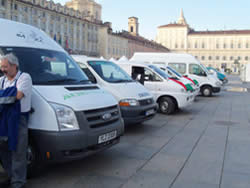
The Viva Palestina convoy gathering in London prior to its departure (www.worldbulletin.ne, September 22, 2010)
The following is the convoy’s itinerary:
a. September 18—the convoy departed from Britain in the morning on its way to France.
b. September 19—the convoy arrived in Paris. It then headed to south France and passed through Lyon and other cities. In France, the convoy was joined by five more vehicles.
c. September 21—the convoy reached Italy and passed through Turin and Milan, where it was joined by seven more vehicles.
d. September 23—the convoy headed to Greece by sea and reached the port of Thessaloniki.
e. September 27—the convoy reached the Turkish border and headed to Istanbul. In Turkey, it was welcomed by the IHH. At a ceremony held for the convoy in Istanbul, IHH leader Bulent Yildirim called on Egypt to let the convoy pass through its territory (IHH website, September 29, 2010; Al-Quds al-Arabi, October 2, 2010).
The ceremony held by the IHH for the convoy in Istanbul, Turkey (flickr.com; right to left: George Galloway, Bulent Yildirim, Zaher Birawi)
f. October 2—the convoy arrived in the Syrian port of Latakia.
g. October 4—the convoy was joined by another convoy from North Africa (Tunisia, Algeria, and Morocco) and a convoy from Jordan (which appears to have included vehicles from the Persian Gulf as well). According to several reports, at that point the convoy consisted of 147 vehicles and about 350 activists, 40 of whom, according to reports, had taken part in the Mavi Marmara flotilla. On the same day, the convoy leaders met with Hamas political bureau chief Khaled Mash’al, who threw a feast in their honor. Khaled Mash’al said that “the convoy participants are waging a winning campaign” that strengthened “the firm stand of the residents in Gaza and in the entire land of Palestine” (Safa, October 6, 2010; Palestine-info, October 5, 2010; Felesteen al-Aan, October 6, 2010). The convoy activists also held a press conference with Moussa Abu Marzouq, Khaled Mash’al’s deputy.
The press conference given in Damascus by the convoy's senior activists and Hamas activist Moussa Abu Marzouq, the deputy of Hamas political bureau chief Khaled Mash’al (Al-Sabil, the Muslim Brotherhood organ in Jordan, October 17, 2010)
Muhammad Nazzal, a senior Hamas activist in Syria (second from right) at a welcome rally held for the convoy. Behind him is Zaher Birawi, the convoy’s spokesman (Al-Sabil, October 9, 2010)
h. October 4—convoy leader and former British MP George Galloway returned to Britain when Egypt denied him entry (Al-Watan, October 9, 2010; Al-Sabil, October 8, 2010).
i. October 14—after the convoy members negotiated with the Egyptian authorities, with the mediation of Syria, the Egyptians allowed the convoy to enter the Gaza Strip provided that the 17 members mentioned above did not enter.
j. October 21—the convoy, with about 500 tons of supplies worth approximately five million dollars, entered the Gaza Strip.
Notes:
[1] Birawi was denied entry as well; however, he somehow managed to enter the Gaza Strip eventually.
[2] Hajj Ismail Nashwan, an Islamic activist from Jordan (most likely belonging to the Muslim Brotherhood) who along with his son was denied entry by the Egyptian authorities. The photograph taken in the Gaza Strip shows him on the backdrop of a poster featuring Hamas founder Sheik Yassin. On the upper left is the emblem of the Islamic Bloc (Hamas’ student movement). The text on the bottom reads: “[Memorial Day] for the martyrdom [istishhad] of the fortunate [Hamas] commanders” (i.e., terrorist operatives who died in the confrontation with Israel). Alrepat.
[3] For details, see the July 20, 2010 article: “The IHH violence against the IDF was similar as the violence against the Egyptian Security Forces“.
[4] Paltimes, Hanein, Alrepat.
[5] Alrepat.
[6] IHH was strongly represented among the convoy activists that clashed with the Egyptian security forces in January 2010. It can be assumed that the two Turkish activists who were denied entry into Egypt belong to the IHH, although at this point we have no proof to that effect.



 RSS
RSS

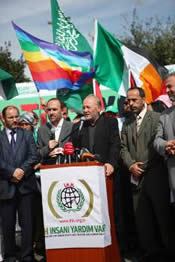

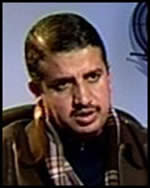
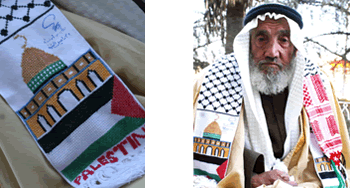
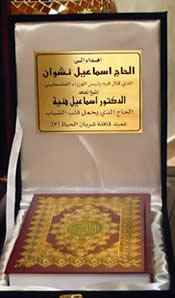
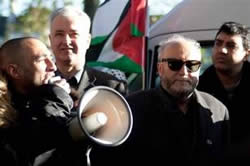

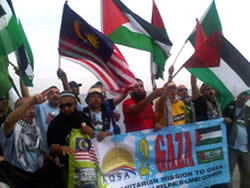

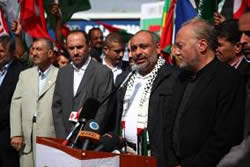

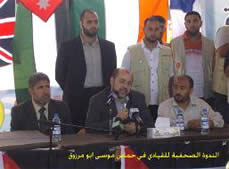
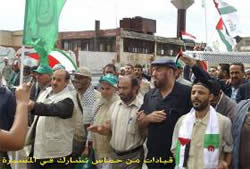
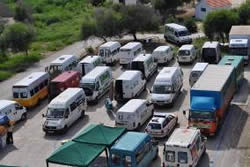
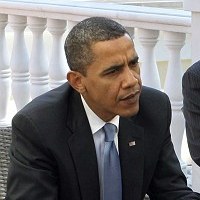
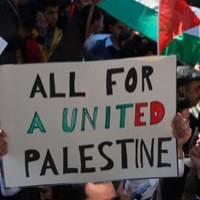
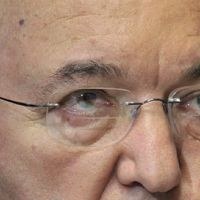
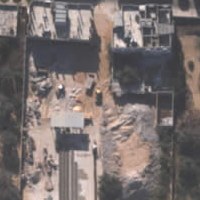
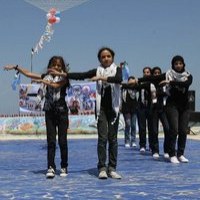




Egyptian Authorities Refused To Allow 17 Activists To Enter The Gaza Strip | #egypt #israel #gaza #aid http://j.mp/czC6i0
RT @CrethiPlethi: Egyptian Authorities Refused To Allow 17 Activists To Enter The Gaza Strip | #egypt #israel #gaza #aid http://j.mp/czC6i0